Exploring the appetite-enhancing effects of nutmeg oil
11/04/2020 / By Evangelyn Rodriguez

In this study, researchers from Kyoto University investigated the appetite-enhancing and locomotor-reducing effects of Myristica fragrans (nutmeg) oil and its active components. They reported their findings in an article published in the Journal of Natural Medicines.
- M. fragrans is widely used to enhance the flavor of sweet and savory foods.
- In Asian countries, it also has a history of use as an herbal medicine that can improve appetite.
- Two of the main active compounds present in nutmeg oil are myristicin and methyl eugenol, phenylpropanoid compounds that have been found to increase the appetite of mice upon inhalation.
- Because of this ability, myristicin and methyl eugenol have attracted the attention of healthcare professionals who care for older people with dementia.
- Many of these patients suffer from hypophagia, which leads to frailty and becoming bedridden.
- Hence, inexpensive appetite-enhancing agents that are easy to administer are particularly desirable.
- The researchers found that inhalation of nutmeg oil, myristicin and methyl eugenol produced appetite-enhancing effects in mice.
- However, only methyl eugenol exerted both appetite-enhancing and locomotor-reducing effects at the same dose.
- According to a previous study, benzylacetone also exerted the same effects at the same dose and even increased the body weight of mice significantly.
- Methyl eugenol, however, did not have the same effect on body weight because the mice experienced olfactory habituation after repeated inhalations.
- A structure-activity study, on the other hand, revealed a carbonyl group in the aliphatic chain that could prevent habituation to aromatic compounds.
The researchers believe that their study provides crucial information for identifying suitable phenylpropanoids that can be used for the long-term treatment of appetite loss.
Journal Reference:
Ogawa K, Ito M. APPETITE-ENHANCING EFFECTS OF NUTMEG OIL AND STRUCTURE–ACTIVITY RELATIONSHIP OF HABITUATION TO PHENYLPROPANOIDS. Journal of Natural Medicines. 27 March 2019;73(3):513–522. DOI: 10.1007/s11418-019-01295-7
Submit a correction >>
Tagged Under:
alternative medicine, appetite loss, food cures, food is medicine, functional food, herbal medicine, Herbs, natural cures, natural medicine, nutmeg, nutmeg oil, phytonutrients, remedies, research
This article may contain statements that reflect the opinion of the author
RECENT NEWS & ARTICLES
COPYRIGHT © 2017 RESEARCH NEWS




















